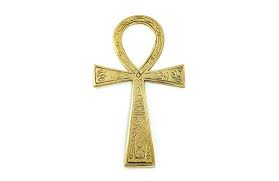
Symbol of inexhaustible life. The gods are frequently depicted holding an ankh to someone’s lips, which is thought to be a gift of “The Breath of Life.” You’ll need this breath in the hereafter.
The Ankh appears frequently in Egyptian tomb paintings and other art, commonly at the fingertips of a god or goddess in pictures depicting the afterlife’s deities bestowing the gift of life on the mummy of a deceased person; this is supposed to symbolise the act of conception. Furthermore, Egyptians frequently wore an ankh as an amulet, either alone or in combination with two other hieroglyphs that meant “strength” and “health.” Mirrors constructed of beaten metal in the shape of an ankh were also used, either for ornamental purposes or to represent an imagined vision into another world.
As a sun-symbol, the Egyptians almost always created notable specimens of the ankh (for tombs or other uses) from gold, the metal they most identified with the sun. A similar metal, such as copper, with a high luster, was also employed on occasion.
